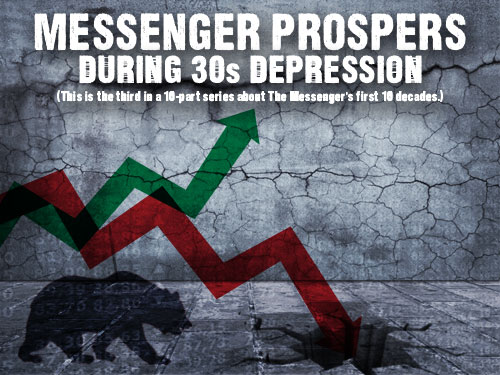 As the Roaring 20s gave over to the Great Depression era, the Baptist Messenger continued to grow in influence and subscriptions. E. C. Routh remained the editor throughout the 1930s, and launched a campaign to double the list of subscribers to 12,000, with the theme “Baptist Messenger readers know, grow, go.”
As the Roaring 20s gave over to the Great Depression era, the Baptist Messenger continued to grow in influence and subscriptions. E. C. Routh remained the editor throughout the 1930s, and launched a campaign to double the list of subscribers to 12,000, with the theme “Baptist Messenger readers know, grow, go.”
Content stayed much the same as the early days of the publication, although more international news crept into the pages, and there was somewhat less advertising.
The nameplate was updated for the first time in the Sept. 7, 1933 issue. It was changed again in the Oct. 25, 1934 issue and once again on Jan. 6, 1938, embodying the words Evangelism, Enlightenment, Enlistment and Enduement.
There was a section about churches and staff, called “Items of Interest,” as well as continuing news of Women’s Missions, OBU, BYPU, Sunday School and other ministries. Editor Routh frequently listed his travels across the state.
During the 1930s, the church budget plan of subscription by which a church subscribed for every family in the membership was inaugurated.
An editorial on March 16, 1939 explained why we need the Baptist Messenger.
Editor Routh wrote: “How will Oklahoma Baptists be informed and enlisted in building Oklahoma Baptist University, in giving for our fatherless and motherless children, in ministering to the sick, in providing for the aged and disabled preachers? We do not get that information from literature that goes into most homes. We know of only one publication that gives all of this information week after week; and we don’t see how any Baptist in Oklahoma can afford to be without that information.
“Someone says that not all the people will read the denominational paper. Well, they don’t all hear the preacher. They don’t all read the Bible. They don’t all take the Sunday school (sic) literature home. But a church with 50 families that makes provision in its budget for 50 Baptist Messengers every week, will have more families knowing what Baptists are doing than they have now. If thirty families out of fifty read the Baptist Messenger, that will be about 500 percent more than most of them are doing now where no special effort has been made to increase the circulation of the Baptist Messenger.
“Let us start today and put the Baptist Messenger, for at least a short time, into every Baptist home in our churches. It will prove a worthwhile investment, not only for the welfare of the homes, but for the enlargement of the world mission task, and for the glory of God.”
During the 15-year tenure of Routh, the printing of the publication was moved from Oklahoma City, where it had been printed by various commercial printers to the university press in Shawnee, while the editorial offices remained at the Baptist Building in Oklahoma City.
Other items of interest appearing on the pages of the Baptist Messenger in the 1930s:
- A 26-page edition on June 12, 1930 was dedicated to OBU.
- Jan. 30, 1930 issue had a story about the little Quaker Church where President Herbert Hoover worshipped, discussing how and when the President arrived, describing the content of the service, and how the President was escorted out to keep people from expressing their views to Hoover.
- March 13, 1930 issue featured two pages of greeting to the BYPU Convention from state officials from Gov. William J. Holloway to Chief Mine Inspector Miller D. Hay.
- The July 30, 1930 Messenger noted that Baptists lead other denominations in 38 of the 77 Oklahoma counties.
- The April 13, 1939 issue featured a story about how a New Testament saved a soldier’s life during World War I.
- A series of articles in 1934 assessed “Why I Am a Baptist and not a . . . Christian Scientist, Episcopalian, Follower of Alexander Campbell, Methodist, Millennial Dawnist, Nazarene, Roman Catholic or Seventh Day Adventist.
- A series on “What Baptists Believe,” from the Scriptures to the Christian Sabbath, appeared from Jan. 30-July 2, 1936.
- In 1937, there was a series of articles on Baptists and . . . children, the church, evangelism, the family altar, fellowship, a new age, prayer, regeneration, salvation, social life, soul liberty, training, home missions, other religious bodies and world conditions.
- • Another series on “Why I am a Baptist” appeared in 1938.
TIME CAPSULE: 1930–1939
The 1930s, while forever remembered as the decade of the Great Depression, were filled with some memorable highlights. The population of the United States is 122.7 million, according to the 1930 Census. The Smoot-Hawley Act, which raised tariffs on 890 manufactured foreign products, is signed into law by President Hoover on June 17, 1930 and within two years, 25 nations had retaliated by raising duties on U.S. goods. The resulting economic nationalism is blamed for deepening the worldwide depression.
Other notable highlights of the decade:
- March 13, 1930, identification of the planet Pluto is made from a photograph taken Jan. 21 at the Lowell Observatory in Flagstaff, Ariz.
- On Jan. 7, 1931, unemployment is estimated at between 4-5 million by Col. Arthur Woods, head of the President’s Emergency Committee for Unemployment Relief.
- May 1, 1931, the Empire State Building, the world’s tallest, is dedicated and opened to the public in New York City.
- In September 1931, a bank panic spreads across the nation; 305 banks close. In October, 522 shut down.
- Oct. 17, 1931, Chicago gangster Al “Scarface” Capone is convicted of income tax evasion and sentenced to 11 years in prison.
- March 1, 1932, Charles A. Lindbergh, Jr. is kidnapped. His body is found on May 12 after a $50,000 ransom had been paid. Outraged public opinion makes kidnapping a federal crime carrying the death penalty.
- May 20, 1932, Amelia Earhart becomes the first woman to fly solo over the Atlantic Ocean.
- July 2, 1932, the term “New Deal” is introduced by Franklin D. Roosevelt in a speech accepting the Democratic nomination for the presidency.
- Nov. 8, 1932, Roosevelt is elected president in a landslide over Herbert Hoover.
- March 31, 1933, the first of Roosevelt’s “Alphabet Soup” of federal relief agencies, the Civilian Conservation Corps (CCC), is initiated. The Agricultural Adjustment Act (AAA), Tennessee Valley Act (TVA), National Recovery Administration (NRA) Public Works Administration (PWA) and Civil Works Administration (CWA) soon follow.
- Feb. 25 1933, the first U.S. aircraft carrier, the U.S.S. Ranger, is christened.
- Nov. 3, 1936, Roosevelt is reelected.
- Aug. 14, 1935, the Social Security Act is signed in to law by Pres. Roosevelt.
- May 9, 1936, the first transatlantic dirigible flight is completed when the Hindenburg lands at Lakehurst, N.J. Almost a year later exactly, on May 6, 1937, the 830-foot-long, Zeppelin is destroyed by a fire at the same site as it approached the mooring mast.
- Oct. 30, 1938, Orson Welles stages his radio play “War of the Worlds,” creating widespread panic.
- Sept. 1, 1939 Germany invades Poland. Two days later, England and France declare war on Germany. The same day, Roosevelt declares the U.S. to be neutral.
Source: What Happened When, A Chronology of Life & Events in America by Gorton Carruth





